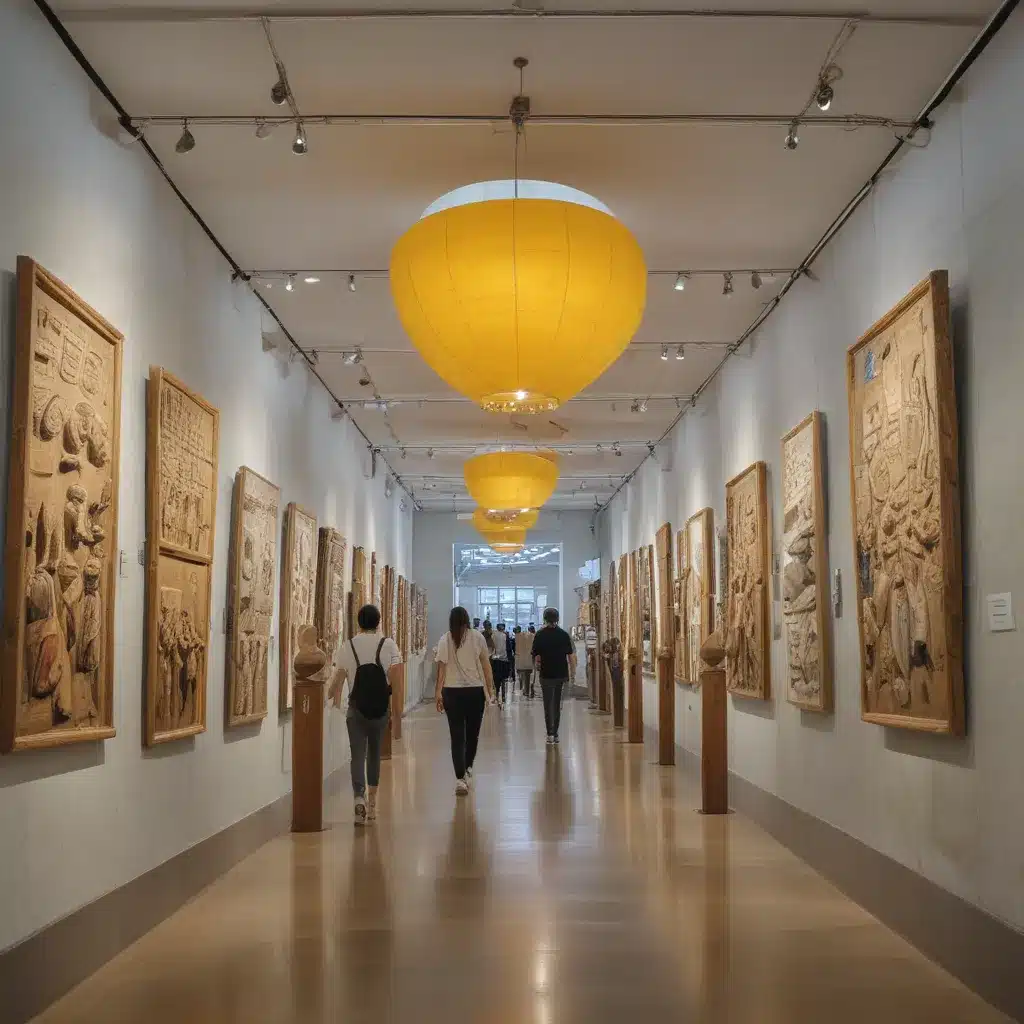
Exploring the Unconventional Side of Seoul’s Art Scene
As I step out of my cozy room at Hotel Stayin Seoul, the bustling streets of the city’s Gangnam district greet me. But today, I’m not heading to the high-end shops or chic cafes that this neighborhood is known for. Instead, I’m on a mission to uncover the quirkier side of Seoul’s cultural landscape – the unique museums and galleries that showcase the city’s most unconventional artistic expressions.
Artistic Curiosities at the National Museum of Modern and Contemporary Art
My first stop is the National Museum of Modern and Contemporary Art (MMCA), nestled right between the historical Gyeongbokgung Palace and modern high-rises. As I wander through the museum’s eight exhibition halls, I’m struck by the sheer diversity of artistic mediums on display.
One moment, I’m captivated by a towering installation made entirely of discarded electronics, a commentary on our tech-driven society. The next, I’m immersed in a mesmerizing video work that transports me to a dreamlike realm. The MMCA’s permanent collection is a treasure trove of both iconic and up-and-coming Korean artists, from the pioneering conceptualist Yun Hyong-keun to the playfully subversive Choi Jeong Hwa.
But the real gems, in my opinion, are the museum’s special exhibitions. Currently, they’re showcasing the works of renowned Chinese artist Ai Weiwei, known for his provocative social and political statements. I spend hours exploring his thought-provoking installations, each one a challenge to the status quo.
Delving into Design at Dongdaemun Design Plaza
Fully energized by the MMCA’s artistic offerings, I decide to venture to another unconventional cultural hub – the Dongdaemun Design Plaza (DDP). Designed by the renowned late architect Zaha Hadid, this futuristic building is a sight to behold, with its swooping curves and shimmering metal facade.
As I step inside, I’m immediately captivated by the DDP’s diverse exhibition program. From cutting-edge fashion showcases to interactive digital art installations, this place is a veritable playground for design enthusiasts. I particularly enjoy the “Design Market,” where local designers and craftspeople peddle their wares – everything from handcrafted ceramics to quirky 3D-printed sculptures.
One of the highlights for me is the DDP’s “Seoul Biennale of Architecture and Urbanism,” a biennial event that explores the intersection of design, urban planning, and social issues. I lose myself in thought-provoking exhibits that challenge traditional notions of architecture and city-building, all while marveling at the sheer creativity on display.
Unconventional Treasures at Seoul’s Indie Art Galleries
After a day of exploring Seoul’s larger, more well-known cultural institutions, I decide to venture off the beaten path and seek out some of the city’s independent art galleries. Armed with recommendations from the Ocula art guide, I set out on a quirky gallery-hopping adventure.
My first stop is Kukje Gallery, a renowned contemporary art space that’s been at the forefront of introducing international artists to the Korean market. As I wander through the gallery’s pristine white halls, I’m struck by the sheer audacity of the works on display – from Anish Kapoor’s mind-bending mirrored sculptures to Haegue Yang’s intricate, sensory-stimulating installations.
Next, I make my way to PKM Gallery, a bastion of Korean abstract art and Dansaekhwa (monochrome painting) movement. Here, I’m captivated by the work of Yun Hyong-keun, a key figure in the history of Korean abstraction. His ethereal, earth-toned canvases evoke a sense of contemplation and tranquility, a refreshing contrast to the bold, attention-grabbing pieces I’ve seen earlier.
As I continue my gallery-hopping odyssey, I stumble upon hidden gems like Barakat Contemporary and Arario Gallery, each showcasing the work of both established and up-and-coming artists from Korea and beyond. I’m particularly fascinated by Arario’s dedication to introducing Indian and Southeast Asian artists to Korean audiences, broadening the country’s artistic horizons.
Uncovering Seoul’s Creative Hubs
With my mind buzzing with the diverse artistic expressions I’ve encountered, I decide to venture beyond the traditional gallery settings and explore some of Seoul’s more unconventional creative hubs.
First, I head to the Samcheong-dong neighborhood, affectionately known as “Gallery Street.” As I stroll along the quaint, tree-lined streets, I’m greeted by a seemingly endless array of independent art spaces, each with its own unique personality. From the cutting-edge Gallery Hyundai to the more experimental Gana Art Center, this area is a veritable playground for art lovers.
But the real highlight for me is stumbling upon the National Museum of Korea, a sprawling institution that showcases the country’s rich cultural heritage. As I wander through the museum’s vast galleries, I’m struck by the seamless integration of tradition and modernity – from centuries-old artifacts to cutting-edge digital animations that bring history to life.
One of my favorite moments is when I happen upon a robot tour guide, who enthusiastically walks me through the museum’s highlights, providing insights and answering my endless questions. It’s a surreal and delightful experience that perfectly encapsulates Seoul’s ability to blend the old and the new, the conventional and the unconventional.
Embracing the Unexpected in Seoul’s Art Scene
As I make my way back to the hotel, my head is filled with the images and impressions of the day’s adventures. Seoul’s art scene, I’ve come to realize, is a tapestry of the unexpected – where ancient traditions and cutting-edge innovation coexist in the most delightful and thought-provoking ways.
Whether it’s the mind-bending installations at the MMCA, the futuristic design explorations at the DDP, or the hidden gems tucked away in the city’s independent galleries, there’s always something new and intriguing to discover. And that’s precisely what makes exploring Seoul’s art scene such a thrilling and rewarding experience.
So, if you find yourself in the bustling capital of South Korea, be sure to venture beyond the well-trodden tourist paths and immerse yourself in the city’s unconventional cultural offerings. Who knows what quirky and captivating surprises might be waiting around the next corner?

